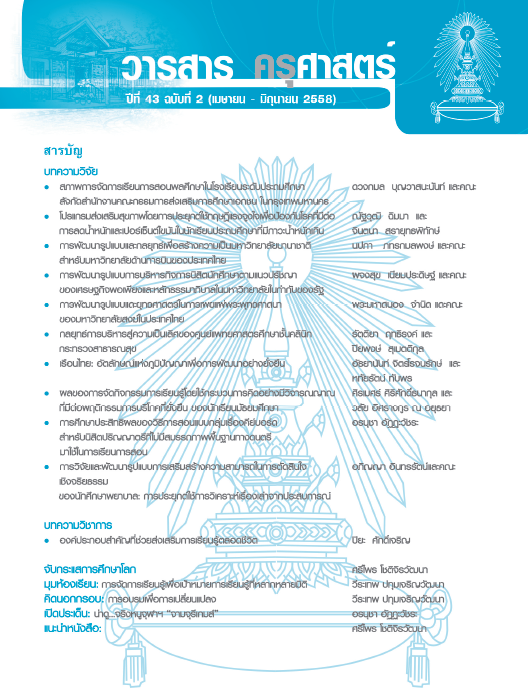การวิจัยและพัฒนารูปแบบการเสริมสร้างความสามารถในการตัดสินใจเชิงจริยธรรมของนักศึกษาพยาบาล: การประยุกต์ใช้การวิเคราะห์เรื่องเล่าจากประสบการณ์
Keywords:
การตัดสินใจเชิงจริยธรรม, การวิเคราะห์เรื่องเล่า, นักศึกษาพยาบาล, ETHICAL DECISION MAKING, NARRATIVE ANALYSIS, NURSING STUDENTSAbstract
การวิจัยครั้งนี้มีวัตถุประสงค์เพื่อพัฒนารูปแบบการเสริมสร้างความสามารถในการตัดสินใจเชิงจริยธรรมของนักศึกษาพยาบาลโดยการประยุกต์ใช้การวิเคราะห์เรื่องเล่าจากประสบการณ์ การพัฒนารูปแบบฯ มีขั้นตอนคือ 1) การศึกษาเอกสาร 2) การพัฒนาและตรวจสอบคุณภาพ และ 3) การทดลองใช้ โดยใช้การวิจัยกึ่งทดลอง แบบกลุ่มเดียววัดก่อนและหลัง กลุ่มตัวอย่าง คือ นักศึกษาพยาบาล จำนวน 56 คน เครื่องมือที่ใช้ในการวิจัย คือแบบวัดความสามารถในการตัดสินใจเชิงจริยธรรมและเกณฑ์การให้คะแนนแบบรูบริกซึ่งมีค่าสัมประสิทธิ์แอลฟาของครอนบาคเท่ากับ .865 ผลการวิจัยที่สำคัญสรุปได้ดังนี้
1) รูปแบบฯ ที่พัฒนาขึ้นมีองค์ประกอบ คือ (1) หลักการ (2) วัตถุประสงค์ (3) ขั้นตอนการจัดการเรียนการสอน (2P-CARE) ซึ่งมีขั้นตอนการสอน 6 ขั้น ได้แก่ ขั้นการนำเสนอเรื่องเล่า ขั้นการรับรู้ประเด็นขัดแย้งเชิงจริยธรรม ขั้นการรวบรวมข้อมูลสำคัญ ขั้นการวิเคราะห์ทางเลือกที่เป็นไปได้ ขั้นการตัดสินใจร่วมกันและวางแผนการปฏิบัติ และขั้นการประเมินผลและสะท้อน (4) การกำหนดเนื้อหาการสอน (5) การวัดและประเมินผลการจัดการเรียนการสอน และ (6) ปัจจัยความสำเร็จในการจัดการเรียนการสอน
2) ผลการใช้รูปแบบฯ พบว่า ภายหลังการทดลอง กลุ่มตัวอย่างมีคะแนนเฉลี่ยความสามารถในการตัดสินใจเชิงจริยธรรมสูงกว่าก่อนการทดลองอย่างมีนัยสำคัญทางสถิติที่ระดับ .05 การเรียนตามรูปแบบฯที่พัฒนาขึ้นช่วยเสริมสร้างความสามารถในการตัดสินใจเชิงจริยธรรม และในการคิดวิเคราะห์อย่างเป็นระบบ สามารถนำไปใช้ประโยชน์ในการปฏิบัติงานและในชีวิตประจำวันได้
The objective of this study was to develop a model for enhancing the ethical decision making abilities of nursing students by using a narrative analysis of experiences. The steps of the model development were 1) document analysis, 2) developing and testing quality, and 3) studying the effects of using the developed model by conducting a one group pre-test post-test quasi-experiment. Fifty-six purposive samples of Royal Thai Army nursing students were selected. The research instrument included an ethical decision making abilities test using rubric scores which the Cronbach’s alpha coefficient was .865.
1) The model was composed of six components; (1) principles, (2) objectives, and (3) the six instructional steps (2P-CARE) which are presenting the story, perception of ethical dilemmas, collecting meaningful data, analysis of possible options, reaching a consensus decision and planning, and evaluation and reflection, (4) contents, (5) measuring and evaluation methods, and (6) the success factors of teaching and learning arrangement.
2) The results from application of the model showed that after the experiment, the sample group had higher ethical decision making abilities scores at the significant level of 0.05. The model seems to have increased the ethical decision making abilities and analytical thinking abilities. This learning can be used in the nursing practice and everyday life.



